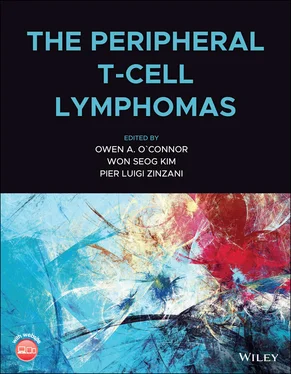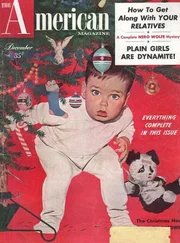Anaplastic Large T‐cell Lymphoma
Microscopically, anaplastic large‐cell lymphoma (ALCL) is commonly marked by large cells with abundant cytoplasm and eccentric, lobulated nuclei [1]. CD30 is highly expressed on the surface of ALCL cells [1]. ALCL is classified in two distinct diseases by the expression of ALK: ALCL, ALK positive and ALCL, ALK negative. The translocations involving ALK gene with various partner genes are essential mechanisms in ALK‐positive ALC. The most frequent translocation, t(2;5)(p23; q35), fuses a portion of the nucleophosmin (NPM) 1 gene on chromosome 5q35 with a portion of ALK on chromosome 2p23 [1]. The NPM1‐ALK fusion gives rise to a chimeric protein consisting of the NPM1 N‐terminus with the ALK catalytic domain [19].
Viral and Chimeric Models
Chimeric models have been created by transplanting bone marrow cells transduced with a retroviral vector carrying NPM1‐ALK cDNA into lethally‐irradiated mice. The first model was reported by Kuefer et al., who infected 5‐fluorouracil‐treated murine bone marrow cells with NPM1‐ALK cDNA using retrovirus and then injected them into lethally irradiated BALB/cByJ mice [20]. Transplanted mice developed B‐lineage large cell lymphomas at four to six months in mesenteric lymph nodes, with metastases clearly associated with aberrant ALK activation [20]. Miething et al. later asked whether B‐cell phenotypes seen in the Kuefer at al. study were attributable to low infection efficiencies and hence low NPM1‐ALK expression. To address this possibility, they compared infection conditions employing low versus high multiplicity of infection and confirmed that lower multiplicity of infection promoted plasmacytomas around 12–16 weeks in mice, while higher multiplicity of infection caused aggressive histiocytic malignancies around 3–4 weeks [21]. Miething et al. also developed a murine model of ALCL by employing a Lox‐STOP‐Lox‐ NPM1‐ALK encoding vector [22]. They then infected bone marrow cells from two sets of mice: one expressing Cre controlled by the lysozyme M ‐promotor ( lysM ‐mice), which is active in the myeloid compartment and the other expressing Cre from the granzyme B ‐promotor ( GrzmB ‐mice), which is mainly active in T cells. Mice transplanted with bone marrow cells from lysM ‐mice developed histiocytic malignancies around four to six weeks, while those from GrzmB ‐mice developed a mixed T‐cell lymphoma/histiocytic malignancy around four to six weeks [22]. Although these models do not precisely mimic human ALCL in humans, they provide versatile tools to examine NPM1‐ALK signaling pathways in vivo .
Chiarle et al. reported the first transgenic mouse in which NPM1‐ALK expression was driven by the Cd4 promoter developed thymic lymphomas and plasmacytomas [23]. They further demonstrated the pathogenic roles of STAT3 in ALCL with NPM1‐ALK expression using the mice [24]. Subsequently, Turner et al. generated mice transgenic for a human NPM1‐ALK fusion gene regulated by the hematopoietic cell‐specific Vav promoter [25]. These mice exhibited development of B‐cell lymphomas and plasmacytomas. Similarly, transgenic mice expressing the NPM1‐ALK transgene regulated by the T cell‐specific Cd2 promoter also developed B‐lymphoid malignancies with variable histological features [26].
In 2019, Rajan et al. used gene editing to establish a mouse model of ALCL, ALK+ after transplantation of hematopoietic stem cells with Npm1 ‐ Alk generated by a CRISPR‐Cas9 method [27]. The lymphoma cells had a large‐cell morphology with CD30 expression accompanied by oligoclonal TCR rearrangements. These features were compatible with those of ALK‐positive ALCL. Therefore, this method may replace traditional approaches to modeling of ALCL in mice.
PDX Models of Anaplastic Large‐Cell Lymphomas
Pfeifer et al. reported a PDX model in which cells from a patient with systemic CD30 +ALCL resistant to chemotherapy were transplanted into severe immunodeficient (SCID) mice [28]. They showed that human ALCL tumor cells xenografted and then serially passaged into SCID mice maintained the original characteristics of the patient’s tumor. This model was also used to demonstrate anti‐tumor effects of the agonistic anti‐human CD30 antibody HeFi‐1 on development of CD30 +ALCL tumors in mice.
Human T‐cell Lymphotropic Virus Type 1 Adult T‐cell Leukemia/Lymphoma
ATLL is caused by persistent infection of the human T‐cell lymphotropic virus type 1 (HTLV1). Clinical presentation of ATLL varies from relatively indolent forms to aggressive forms. ATLL develops only a small part of HTLV1 carriers after an incubation period of about 60 years from HTLV1 infection [1]. Additional genetic and epigenetic abnormalities are thought to be required for the onset of ATLL. In addition to gag, pol and env genes, the HTLV1 genome encodes accessory proteins including Tax, a transcriptional activator and HTLV1 basic leucine zipper factor (HBZ), a nuclear protein, both of which play essential roles in cellular proliferation, survival, and genetic stability of ATLL cells [29].
Mice Expressing HTLV‐1 Viral Proteins
Several lines of transgenic mice expressing Tax under the control of viral promoters HTLV1 long terminal repeat have been developed. These mice develop mesenchymal tumors [30], arthritis [31], and osteoporosis [32]. Mesenchymal tumors were observed in the nose, ear, foot, and tail and were characterized by a spindle‐cell component and granulocyte infiltration. However, these models do not mimic human ATLL. Other investigators generated Tax transgenic mice using promoters activated in T cells [33, 34]. Among these, transgenic mice expressing Tax from the Cd3‐epsilon promoter developed a variety of tumors dependent on the lines, including mesenchymal tumors, and salivary and mammary adenomas [33]. Transgenic mice expressing Tax in thymocytes under control of the Lck proximal promoter developed thymic T‐cell lymphomas [34]. Moreover, the other transgenic mice expressing Tax using the GrzmB promoter developed large granular lymphocytic leukemia, lymphadenopathy, extranodal disease and hypercalcemia, resembling human ATLL [35, 36].
Transgenic mice expressing HBZ have also been developed [37, 38]. Mice expressing HBZ driven by the Cd4 promoter showed inflammatory lesions of lung and skin, accompanied by increase of effector/memory and regulatory CD4 +T cells [37]. Approximately 40% of these mice also develop T‐cell lymphomas after a long latency, reminiscent of human ATL. HBZ transgenic mice constructed using the GrzmB promoter were also reported [38] and exhibited lymphoproliferative disease, osteoporosis, splenomegaly, and hypercalcemia, similar to lymphoma‐type of ATLL. HBZ/Tax double transgenic mice in which both genes were controlled by the Cd4 promoter showed phenotypes similar to those of HBZ single transgenic mice [39]. Despite this progress, to date a model fully replicating human ATLL disease has not yet been established likely due to the complexity of the human ATLL disease.
PDX Models of Adult T‐cell Leukemia/Lymphoma
Xenograft mouse models transplanted with ATLL patient‐derived cells have been examined [40]. In these models, immunodeficient SCID and NOD/SCID recipient mice displayed multiple features of human ATLL disease, namely, aberrant lymphocyte infiltration in liver, spleen, lung, peritoneum, and other organs. These models have helped define mechanisms underlying HTLV1 infection, clonal proliferation and the immune response against HTLV1 and have contributed to development of targeted therapies. For example, treatments using the antibody against C─C chemokine receptor type 4 and an inhibitor of histone deacetylase have been tested in these models.
Читать дальше












